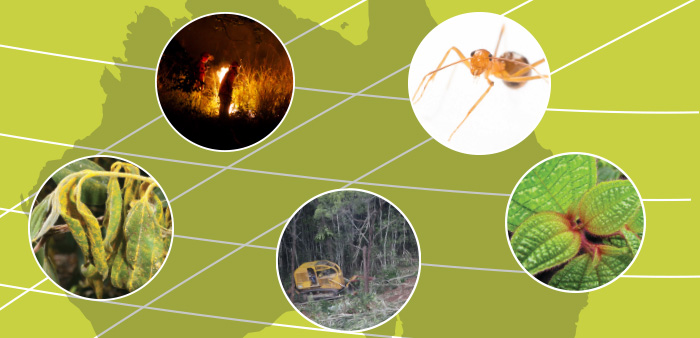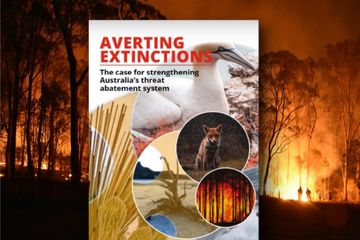
You’d think that when many species or ecological communities are endangered by the same process – such as a disease, predator or habitat destruction – the federal government would formally recognise that, set up a national taskforce, expeditiously prepare a plan to combat the threat, and do everything it could to implement that plan.
In fact, the federal government has the means to do just this by listing such dangers as ‘key threatening processes’ (KTPs) under our national environmental law and preparing ‘threat abatement plans’ (TAPs).
A threat can be listed as a KTP if it threatens or may threaten the survival, abundance or evolutionary development of two or more native species or ecological communities. For example, feral cats are listed as a KTP because their predatory habits threaten more than 150 species.
It makes great sense to give high priority to combatting KTPs because relatively few threats cause most declines, and finding enduring solutions – such as better control techniques or stricter regulation – would typically be more effective and less expensive over the long term than trying to save threatened species one by one. It would also help the myriad of species not listed as threatened (often due to a lack of data) that are also in decline.
And yet a discussion paper we have just released, KTPs & TAPs: Australia’s failure to abate threats to biodiversity, finds that:
- Many leading threats to Australian biodiversity are either not listed as KTPs or are moribund listings that lack an abatement plan.
- KTP nominations assessed over the past decade have taken from three to seven years to accept or reject, and one still under assessment is more than 10 years old.
- No recent KTP nominations have been assessed.
- Almost a third of listed KTPs have no abatement plan (including KTPs for which the threat level is rising) and fewer than a third of KTPs have an up-to-date plan.
- Moderate to good progress on threat abatement has been reported for less than 40% of KTPs.
We invite feedback on the paper and ideas on how to strengthen threat abatement processes. We hope to hold a workshop in 2018 to develop a conservation sector proposal for reform.
Invasive species as KTPs
Invasive species make up two-thirds of the 21 listed KTPs. A KTP/TAP type process is often the only effective way to address invasive species threats, particularly when abatement is ecologically, technically and socially complex and needs to involve several jurisdictions. But there are no national abatement plans for the majority of major invasive species threats.
For the past six years at least, the government has refused to assess or list any more invasive species KTPs. The main reason given for refusing to assess six public nominations (including for myrtle rust, buffel grass and feral deer) is that invasive species threats are encompassed within a catch-all ‘novel biota’ KTP. But this is a useless listing and no action has resulted apart from publication of a few fact sheets. In a seventh case (invasive freshwater fish), the environment minister refused to list the KTP, contrary to advice by the Threatened Species Scientific Committee.
Obligation-free processes
Although the Australian Government has international obligations to abate threats to biodiversity, there is no obligation under our national environmental law (the EPBC Act) to list the major threats or act on them. Leading threats to biodiversity such as inappropriate fire regimes and altered hydrological regimes are not even listed. Others such as invasive escaped garden plants and land clearing lack a TAP. And only a few invasive species threats have a TAP.
The environment minister has complete discretion about whether to accept the advice of the Threatened Species Scientific Committee to assess a KTP nomination, list a KTP or prepare a TAP, and can delay decisions for years. This means our national system for recognising and abating threats is highly vulnerable to political interference. The same vulnerability applies to the listing of threatened species and ecological communities and preparation of recovery plans.
KTP listings come mostly obligation free. Even if the environment minister decides that a TAP should be prepared, the law obliges implementation only on Commonwealth lands. A KTP listing or TAP does not generate any obligations for other governments, landholders or anyone whose actions may exacerbate the KTP. There are no requirements for monitoring or reporting on KTP status. The one reporting obligation is a five-year review of each TAP, but with no requirement for this review to be independent.
Of 11 abatement plans that have been reviewed at least once (and for which the review is publicly available), the reviews indicate good progress on implementing four plans, moderate progress for four and poor progress for three. Although moderate to good progress has been reported on only just over a third of listed KTPs, this demonstrates that major threats are surmountable.
A system in poverty
Stymieing KTP listings appears to be a deliberate government strategy to limit funding demands because there is far too little funding for abating the already-listed KTPs. There is no information about how much Australia spends on abatement (from government and non-government sources), and there has never been an estimate of how much is needed to properly implement abatement plans. However, it is clear from the limited progress that the gap between available funding and the funding needed for implementing plans is large.
Changes needed
The fundamentals of the current model seem sound – that major threats should be listed nationally and that a listing should catalyse a national plan and collaborative action to abate the threat. And as shown by the few cases in which good abatement progress is being made – for longline fishing and red fire ants, for example – major threats can be abated. Here are some broad changes we think are needed to drive abatement of Australia’s major threats to biodiversity.
Make threat abatement a high national priority
We need greater recognition that an effective KTP/TAP system is essential for arresting loss of biodiversity – that developing solutions to major threats is more effective and cost-effective than a species-by-species approach and benefits myriad other species at risk.
To drive reform of the KTP/TAP system, Australia needs an ambitious (but realistic) conservation strategy that specifies long-term goals for threat abatement. That ambition needs to be then reflected in each of the TAPs.
Enlisting commitment from state and territory governments is essential. The federal government should pursue an intergovernmental agreement with the states and territories to achieve long-term abatement goals.
Strengthen governance and accountability
Decisions to assess and list KTPs and prepare TAPs should be free of political influence and not subject to ministerial discretion. We endorse the recommendation by the Places You Love Alliance for an independent National Sustainability Commission to undertake such functions. It is also worth considering co-governance models, such as exemplified by the industry-government partnerships, Animal Health Australia and Plant Health Australia.
More meaningful, independent and regular reporting is needed. For the sake of credibility and rigour, the five-yearly reviews of threat abatement plans should be done by expert reviewers independent of government. An annual progress report, based on meaningful abatement indicators, should be presented to the federal parliament. This needs to be underpinned by monitoring of threatening processes and the species and ecological communities at risk.
Systematically list KTPs for all matters of national environmental significance
The KTP list under the EPBC Act should be the authoritative list of major threats to Australian biodiversity. The listing process needs to be more systematic to properly reflect the major threats. A systematic expert process can be supplemented by a public nomination process to fill gaps and keep the KTP list up to date.
The KTP list should expand to recognise threats to other ‘matters of national environmental significance’ protected under the EPBC Act, including migratory species, Ramsar wetlands and world heritage areas. The list should also more adequately encompass emerging threats (as exemplified by the listing of red imported fire ants as a KTP) to stimulate early cost-effective action before they become entrenched threats.
Strengthen obligations for abatement
For each KTP, it should be mandatory to prepare a TAP (or equivalent) to specify long-term abatement goals and shorter-term targets, the research and actions needed to achieve them and a monitoring regime. A TAP should serve as a national statement of what is needed to achieve abatement and as the basis for monitoring and reporting on the status of the KTP and abatement progress.
Federal leadership is needed to enlist all states and territories to implement TAPs. As with other national priorities, this requires intergovernmental agreements, attractive funding arrangements and good negotiation skills.
If state and territory governments fail to participate in implementing TAPs, the federal government should be obliged to consider options for over-riding or compensatory measures, such as using its own laws to limit land clearing or regulate trade in invasive plants.
Obligations should extend to individuals and corporations. All Australians are bound by the EPBC Act to avoid having a significant impact on matters of national environmental significance. They should also be bound to avoid actions likely to significantly exacerbate a KTP.
Commit to long-term funding to achieve abatement targets
A government demonstrates it is serious about mitigating harms when it is prepared to fund the necessary actions. To assess funding needs, each TAP should include an estimate of costs to achieve 10–20-year targets. New funding sources such as levies and taxes should be considered to provide long-term base funding for implementing TAPs.
We welcome feedback and ideas.









